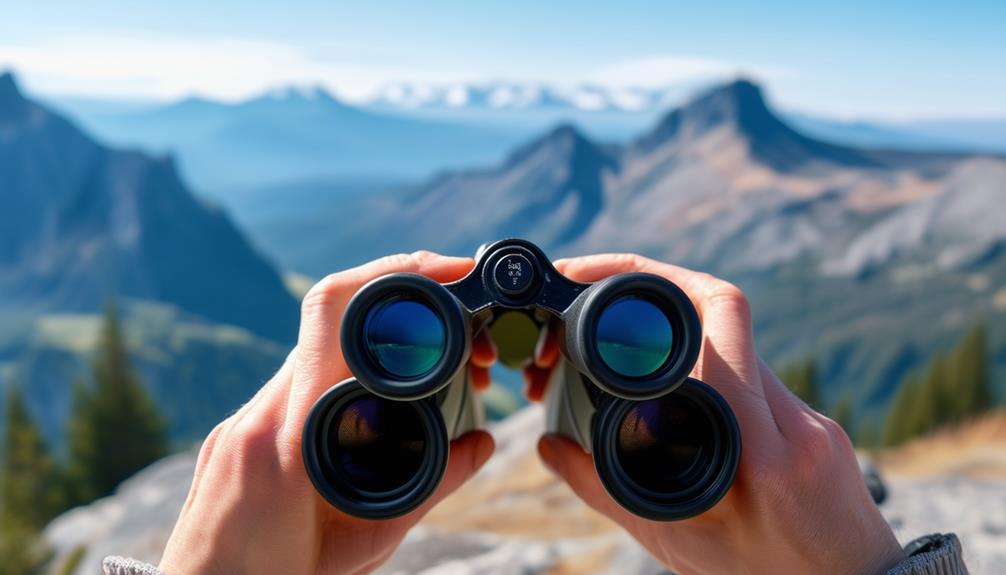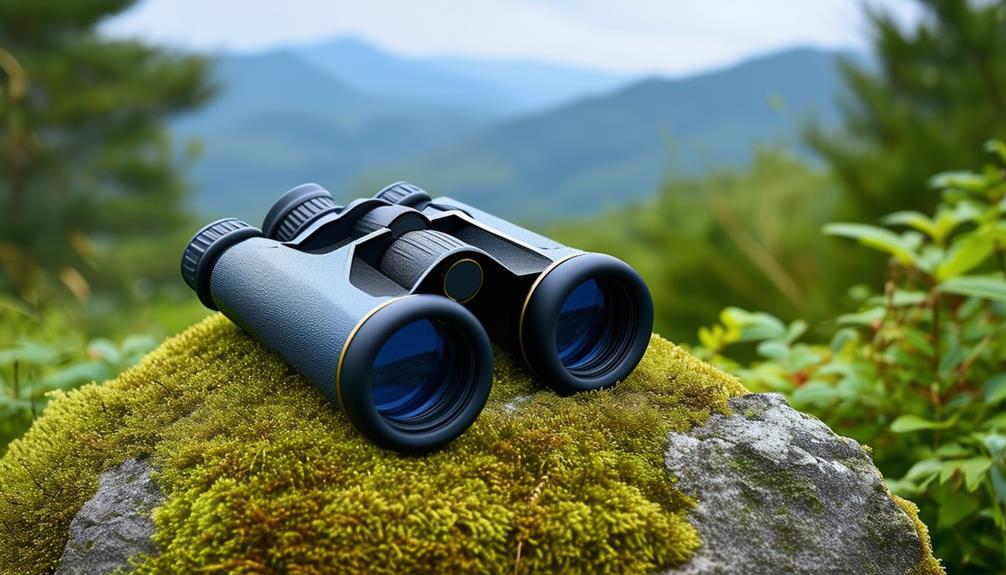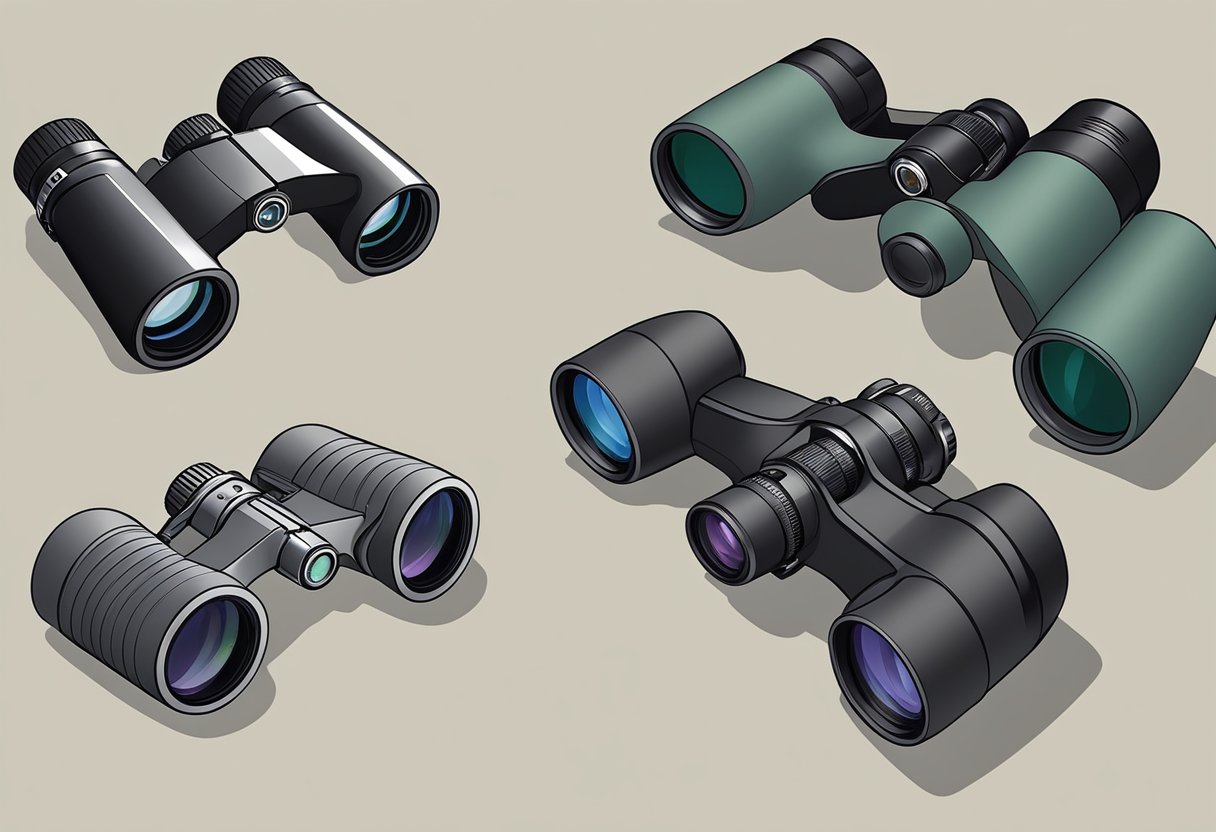How to Properly Maintain and Clean Your Binoculars
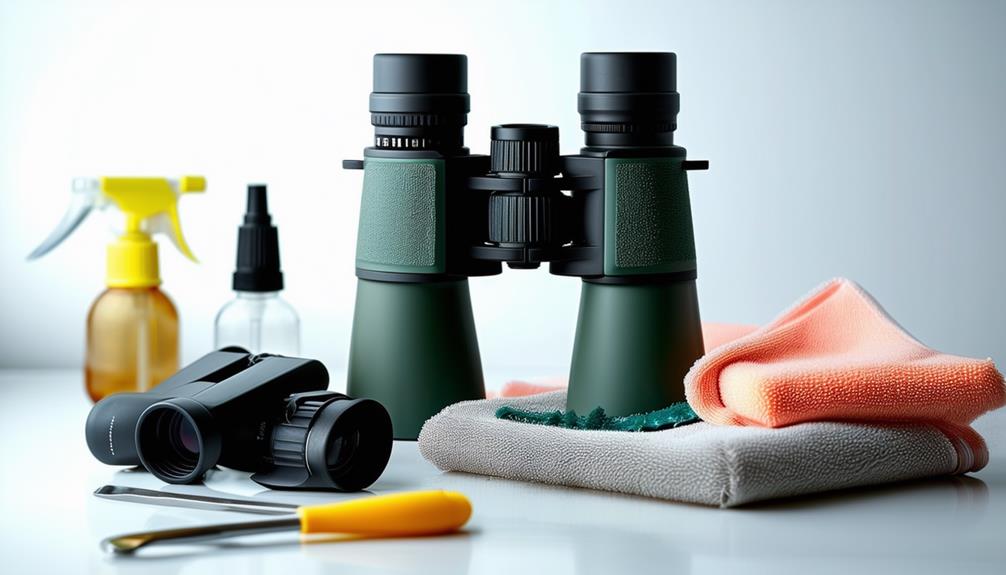
Properly maintaining and cleaning your binoculars not only extends their lifespan but also ensures optimal performance. Start by recognizing the importance of clean, debris-free lenses. Use a lens pen or specialized cleaning solution with a microfiber cloth to gently clean the lenses. For more persistent grime or unexpected weather conditions, employ straightforward techniques to maintain and clean your binoculars, ensuring they are always ready for your next adventure.
Importance of Proper Care
Proper care of your binoculars is crucial to ensure they function optimally and have a long lifespan. Regular maintenance helps preserve the delicate lens coatings, which are essential for clear viewing. By using the right cleaning solutions and handling your binoculars properly, you can prevent unnecessary damage and wear.
Following the manufacturer's recommendations for cleaning and upkeep protects your investment. Improper care can result in scratches on the lenses or damage to the internal mechanisms, which can be costly or even impossible to repair. Educating yourself and others about the importance of regular maintenance promotes responsible usage within the bird-watching community.
Tips for Keeping Lenses Clean
To maintain your binocular lenses in excellent condition, always use a lens pen or a cleaning solution specifically designed for optics. Avoid contact with food or greasy substances, as these can be difficult to clean and may damage the lens coatings. Regularly inspect your lenses and gently wipe away any smudges or debris with a microfiber cloth.
Avoid Food Contaminants
Using the rain guard as a food shield can prevent crumbs and spills from contaminating your binocular lenses. Whether you're snacking or sipping a beverage, keeping food away from your lenses is crucial. Contaminants like pizza sauce or crumbs can easily find their way onto your lenses, reducing visibility and potentially causing long-term damage.
If you do get food on your lenses, clean them properly. Start by using a soft lens cleaning cloth to gently wipe away any debris. Avoid using rough fabrics like your shirt, as these can scratch the delicate coatings on the lens. The key is to be gentle yet thorough.
In case of severe contamination, such as vomit, rinse the lenses immediately with clean water to prevent damage and maintain optical clarity. Never use substances like Windex or saliva to clean your binocular lenses, as these can degrade the optics over time.
Use Proper Tools
Ensure you're using the correct tools to keep your binocular lenses clean and scratch-free. Start with a lens cloth specifically designed for optics. These cloths are soft and gentle, preventing damage to the delicate coatings on your lenses. Avoid using harsh substances like Windex or saliva, as these can cause long-term damage.
For dust and small debris, use compressed air to blow away particles without touching the lens surface, reducing the risk of scratches. A lens brush with soft bristles is also effective for removing dust without leaving marks.
For smudges or fingerprints, a lens pen is your best option. The pen's tip contains a special cleaning compound that safely removes oil and grease, leaving your lenses crystal clear. Use the pen's brush end first to remove any loose debris before cleaning the lens surface.
Regular cleaning with these appropriate tools ensures optimal performance and extends the lifespan of your binoculars. By investing in the right gear, you'll maintain your optics in excellent condition and enjoy clearer views for years to come.
Proper Lens Cleaning Techniques
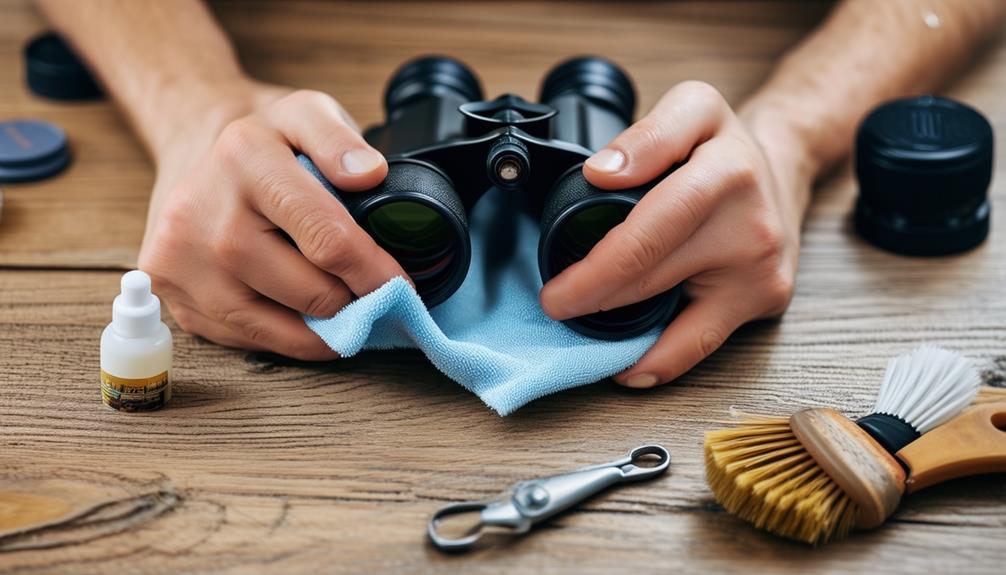
When cleaning binocular lenses, avoid breathing on them to prevent moisture and debris transfer. Use a microfiber cloth for the task. Gently wipe the lenses in a circular motion to remove dust and smudges without pressing debris into the lens surface, which can cause scratches.
Hold the binoculars upside down while cleaning to allow loosened dirt to fall away from the lenses. If there's stubborn debris that the soft cloth can't remove, use a cotton swab dipped in water or a specialized optics cleaning solution. Carefully wipe the affected area in a gentle circular motion.
Avoid applying too much pressure, as this can embed debris into the lens and cause damage. Start with the least abrasive method and escalate only if necessary.
General Care Tips
To keep your binoculars in optimal condition, focus on proper storage, regular maintenance, and careful handling. Store them in a clean, dry case and use a shoulder harness to reduce strain during extended use. Always set the focus to infinity and retract the eyecups when not in use to protect the lenses and internal mechanisms.
Proper Storage Practices
Storing your binoculars in a clean, dry bag or case ensures they remain free from dust and debris. When not in use, proper storage safeguards the lenses from potential scratches or damage. Always use lens caps to shield the lenses during storage or transport. These simple measures can greatly prolong the life of your binoculars.
It's crucial to avoid exposing your binoculars to extreme temperatures or high humidity, as such conditions can harm the delicate internal components and affect overall performance. A cool, dry place is ideal for storage to prevent moisture from seeping in and causing mold or other damage.
Regularly inspect the case or bag you're using to store your binoculars for any dirt, debris, or signs of wear. A dirty or worn-out case won't offer the protection your binoculars need. If you notice any issues, clean the case or replace it to maintain optimal safeguarding.
Following these proper storage practices will help ensure that your binoculars are always ready for use, in top condition, and free from unnecessary damage. Good storage habits are essential for maintaining the quality and longevity of your binoculars.
Regular Maintenance Activities
Regular cleaning and careful handling are essential for maintaining the performance and longevity of your binoculars. Routinely wipe down the exterior with a damp cloth to remove dirt and dust, preventing grime accumulation which can cause damage over time. For the lenses, use a microfiber cloth designed specifically for optics, as using the wrong type of cloth can scratch the lenses and degrade image quality.
Always keep the twist-up eyecups retracted when you're not using the binoculars to prevent unnecessary strain and potential damage. Additionally, avoid leaving your binoculars on car seats while driving, as the jostling and vibrations can lead to misalignment or other damage.
Using a shoulder harness can help reduce neck strain during extended use, making your experience more comfortable and reducing the likelihood of dropping your binoculars. When you're done using them, store your binoculars in a clean, dry bag to keep them free from moisture and dust, which are detrimental to their longevity.
Handling and Usage Guidelines
Proper handling and usage of your binoculars will significantly extend their lifespan and maintain their performance. Follow these essential guidelines:
Protect the lenses:
- Always use lens caps when your binoculars aren't in use to prevent dust and scratches.
- If the lenses get dirty, clean them gently with a soft, clean cloth. Avoid using rough materials like your shirt.
Handle with care:
- Don't leave your binoculars on car seats where they can be bumped or fall.
- When transporting them, set the focus to infinity for porro prism binoculars to maintain optical alignment.
- Retract the twist-up eyecups to prevent damage.
Wear them correctly:
- To reduce neck strain during extended use, use a shoulder harness to distribute the weight evenly.
- Avoid swinging the binoculars by their strap while walking, as this can cause accidental drops or damage.
Cleaning Binocular Lenses
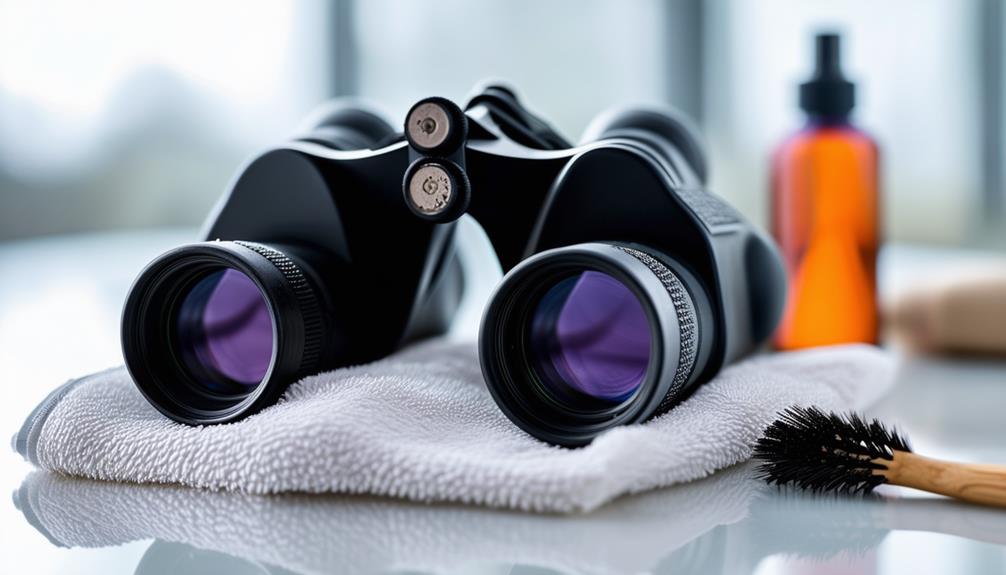
Cleaning your binocular lenses properly ensures you get the best possible view and prolongs their lifespan. Start by using brief bursts of air to blow away any loose dust or debris, preventing scratches when you wipe the lenses. Next, gently clean the lenses with a microfiber cloth, moving in a circular motion from the center outward. For stubborn smudges, apply a small amount of lens cleaning solution or isopropyl alcohol to the cloth. Avoid abrasive materials or harsh chemicals as they can damage the lens coatings.
Ensure lenses are completely dry before storing them to prevent water damage. Here's a quick summary to keep your lenses spotless and your views crystal clear:
| Step | Action | Why It Matters |
|---|---|---|
| Blow off debris | Use brief bursts of air | Prevents scratches from loose particles |
| Wipe with microfiber | Use a microfiber cloth | Gentle cleaning without abrasives |
| Use cleaning solution | Apply lens cleaner or isopropyl alcohol | Removes stubborn smudges effectively |
Cleaning Exterior and Body
After ensuring your lenses are spotless, it's time to clean the exterior and body of your binoculars for optimal performance. Start by wiping down the barrels, rims, and focus wheels with a damp cloth to remove any dirt and dust. Ensure the cloth is only slightly damp to avoid moisture seeping into sensitive areas. Next, use compressed air to clean tight spaces and crevices on the exterior, taking care to use controlled air pressure to prevent damage to delicate parts.
Follow these steps:
- Damp Cloth: Gently wipe down the barrels, rims, and focus wheels to remove surface dirt.
- Compressed Air: Carefully blow out dust from tight spaces and crevices, ensuring you use a controlled air pressure.
- Soft Lens Brush: Use this to gently remove any remaining loose debris from the exterior surfaces.
Cleaning Rubber Eyecups
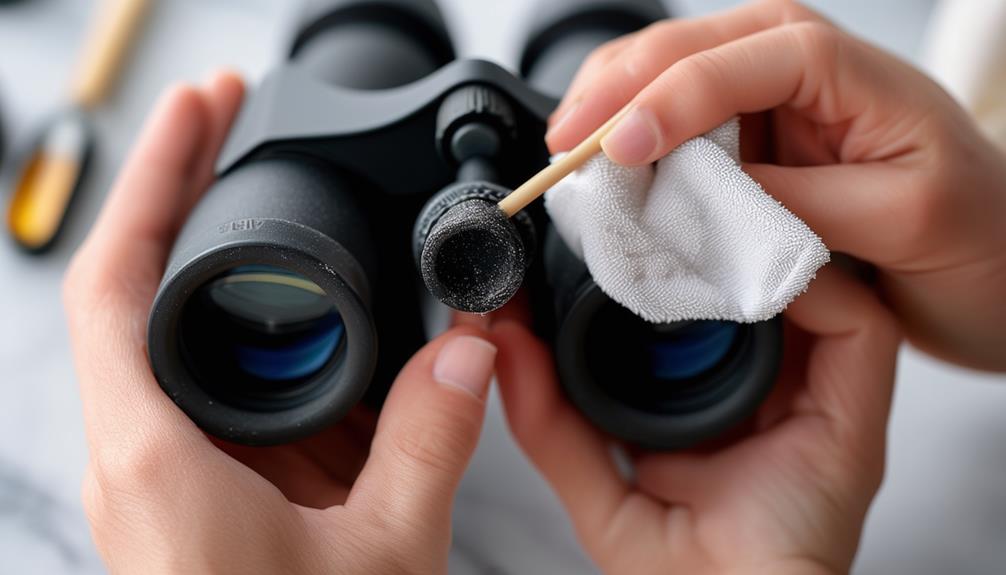
To maintain your rubber eyecups in excellent condition, start by gently cleaning them with water or a mild cleaning solution. Moisten a soft cloth or brush with the solution and clean the eyecups to remove dirt and grime without damaging the material. Use tools specifically designed for rubber eyecups to avoid scratching or tearing the surface.
Wipe the rubber eyecups in a circular motion, paying extra attention to sticky or rough areas. The goal is to preserve the comfort and usability of your binoculars without applying excessive pressure, which could stretch or damage the rubber. Let the cleaning solution do most of the work, and be patient.
After cleaning, use a dry, soft cloth to remove any remaining moisture. Allow the eyecups to air dry completely before using your binoculars again. Regular cleaning with these gentle methods not only keeps the rubber eyecups looking good but also extends their lifespan.
Maintenance Best Practices
Maintaining the rubber eyecups clean and regularly inspecting your binoculars for wear and damage ensures they remain in optimal working condition. To effectively sustain your binoculars, adhere to these maintenance best practices:
Regular Inspections: Frequently check your binoculars for signs of wear, misalignment, or damage. Early detection of issues can prevent more severe problems later on.
Proper Storage: Store binoculars in a protective case in a cool, dry place. This prevents damage from humidity or extreme temperatures, which can affect the lenses and other components.
Use Lens Covers: Always keep the lens covers on when your binoculars aren't in use. This protects the lenses from dust, scratches, and accidental damage.
Additionally, use a lens pen for quick touch-ups in the field to keep your lenses clean and free of smudges. For complex issues or if you're unsure about any maintenance tasks, seek professional cleaning services.
Following the manufacturer's instructions for long-term storage will also help maintain the prime condition of your binoculars. Adhering to these best practices will ensure your binoculars remain reliable and functional for years to come.
Detailed Cleaning Steps
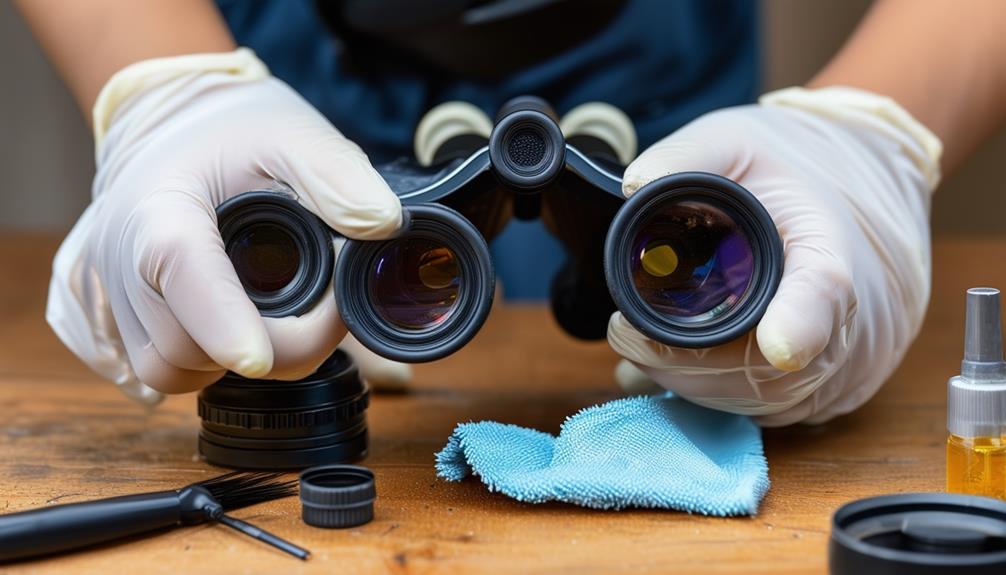
Start by using a blower brush to remove any loose dirt and debris from the exterior of your binoculars. This step helps prevent scratches during more detailed cleaning. After blowing off the dust, wipe down the exterior with a damp microfiber cloth, paying special attention to the hinges and moving parts to maintain their functionality.
Next, apply a small amount of lens cleaning solution to a microfiber cloth and gently wipe the lenses in a circular motion, beginning from the center and moving outward. This technique helps maintain the integrity of the lenses and ensures clear viewing. Be especially careful during this step, as the lenses are delicate and can easily be damaged.
Don't forget to clean the eyecups. Remove them and clean them separately using a mild soap solution to ensure they remain comfortable and clear for viewing. Avoid disassembling other parts of the binoculars unless you're experienced with such tasks.
Conclusion
Proper maintenance and cleaning of your binoculars ensure they remain in optimal condition for years. Regularly inspect and clean the lenses using appropriate techniques, and store them correctly to maintain clear, sharp views. Handle them with care and adhere to the best maintenance practices. With minimal effort, your binoculars will continue to be a reliable companion for all your outdoor adventures.

